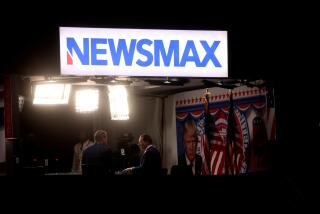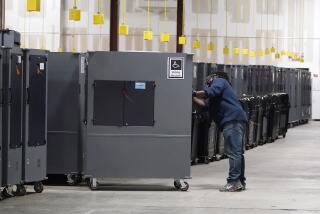McNall Agrees to Plead to Fraud Charges : Kings: Prosecutors say he defrauded banks for more than $236 million. Gretzky also allegedly was deceived.
- Share via
King President Bruce McNall was formally charged Monday with defrauding six banks of more than $236 million over 10 years in a long-awaited plea agreement with federal prosecutors, the culmination of a dizzying collapse that is virtually unprecedented in the sports business.
The four-count criminal information consists of two counts of bank fraud, one count of conspiracy and one count of wire fraud. In December, McNall plans to formally plead guilty to all counts, according to his attorney.
The charges, which stem from a nine-month investigation, also allege for the first time that McNall and his executives in one deal took advantage of King superstar Wayne Gretzky, his longtime friend and investment partner.
According to the charges, McNall improperly pledged their horse, Honor Grades, to Union Bank as collateral for an $850,000 loan without telling Gretzky, representing to the bank that the horse was 100% owned by McNall’s Summa Stables.
Gretzky, who bought 25% of the horse in 1991, isn’t mentioned by name in the papers and is referred to only as “an investor.” Sources confirmed, however, that it is Gretzky. McNall lawyer Tom Pollack contended that any such action “was done by lower-level employees” without McNall’s knowledge. Neither Gretzky nor his agent returned phone calls.
In April, The Times reported that McNall was the subject of a federal bank fraud investigation, and in August reported that he had struck a plea agreement with prosecutors. On Monday, Pollack publicly acknowledged that his client will plead guilty to the felony charges, most likely next month.
“Bruce is saying he did wrong, and he is taking responsibility,” Pollack said. Pollack further said that the false loan applications were part of a larger effort to keep McNall’s business afloat while trying to put together new ventures--such as a new sports arena--that would generate money to pay off McNall’s debts.
Asst. U.S. Atty. Peter S. Spivack called McNall “the primary motivator and beneficiary of this scheme” to defraud the banks.
“It wasn’t called McNall Sports and Entertainment for nothing. The company was the man and vice-versa,” said Spivack, who said that “a 10-year period without discovery is pretty extraordinary.”
Technically, McNall faces a maximum of 45 years in prison. Realistically, under federal sentencing rules, McNall is said to currently face nine years in prison, with the possibility that the amount could be chipped away for extensive cooperation with prosecutors and depending on how a judge views the seriousness of the case. Sources close to McNall say he is hoping to whittle the term down to five years or less.
Over the past three months, prosecutors and McNall lawyers have hammered out the terms and wording of the charges made public Monday, which portray a systematic effort dating back to 1984 by McNall and his associates to defraud bankers, many of whom were enamored with McNall’s glitzy image and who eagerly lined up to lend him money.
The charges largely involve providing phony documents that overstated McNall’s assets and understated or failed to list his debts. In one case, replicas of famous sports jerseys were bought and continually washed to appear authentic so bankers would believe that their loans were backed by valuable sports memorabilia.
Prosecutors allege that McNall’s loan schemes started with a $35-million request from European American Bank and the Dutch unit of the giant French bank Credit Lyonnais. The loan was made on behalf of Gladden Entertainment, a movie production firm McNall owned with longtime Hollywood figure David Begelman.
McNall, the charges say, submitted phony financial statements that overstated his net worth in personally guaranteeing the loan. The loan amount was later boosted to $50 million in 1985, and to $60 million in 1988.
The fact that the charges show McNall falsified loan documents as early as 1984, sources say, poses a problem for McNall’s camp, which has been suggesting that the loan schemes were triggered in part out of desperation following a near financial collapse in 1987 caused by problems at Gladden.
Sources familiar with the case said that a 10-year pattern of conduct--especially the overt way some documents were faked--does not bode well for that argument, making it difficult to argue that financial duress provoked the actions. Federal authorities are said to have been shocked at how blatant the fraud has been in some cases.
The banks McNall is charged with defrauding are Bank of America, European American Bank, Credit Lyonnais, Bank of California, First Los Angeles Bank and Union Bank. In addition, he is charged with diverting about $13 million from a coin partnership he organized with Merrill Lynch and $7 million from King ticket sales when his bank funds dried up.
The charges accuse McNall and his executives of creating sham companies to obtain loans, such as a $14-million loan from Credit Lyonnais secured by $15 million in coins that never existed. It also accused McNall and his executives of bribing bank officials to win their favor, including making a $50,000 loan to a Bank of America officer.
One of the more elaborate schemes involved McNall and his associates arranging a $20-million personal loan from Bank of America, using as collateral phony financial statements listing $15 million in rare coins, which again did not exist.
To keep the bank and other institutions from discovering that the coins did not exist, the charges say, McNall and his executives maintained that the coins had been traded for sports memorabilia. As it turns out, McNall didn’t own the memorabilia, but instead held it on consignment from memorabilia dealers.
After he returned the memorabilia to the dealers, the charges say, McNall and his executives duped the banks by purchasing sports items and making them look old.
McNall’s sudden change of fortune would be staggering for any business executive, much less one who only a year ago was considered one of the most progressive owners in sports. By luring such stars as Gretzky to his Kings, McNall did what skeptics once thought impossible: sell out hockey games in Southern California.
But the road that led McNall from president of the Arcadia High School coin club to the national spotlight took a detour when it became clear that much of his business empire was built on sand. McNall filed for personal bankruptcy in May, shortly after selling 72% of the team to Jeffrey Sudikoff and Joseph Cohen to rid himself of his Bank of America loans.
McNall was expected as early as today to give up his high-profile title of president of the Kings, although he will continue to work for the team and draw a six-figure salary through 2001.
Cohen said: “McNall hasn’t (resigned) but I know he intends to. I consider Bruce a friend. I want to be supportive. My first priority is to the L.A. Kings and our fans.”
Pollack said that McNall first became aware of the bank fraud investigation on April 20, when subpoenas were served and then he began cooperating with prosecutors.
While saying he does not want to downplay McNall’s role in the schemes, Pollack said that the crimes were “institutional” in nature, involving a large number of employees in McNall’s organization.
But prosecutor Spivack said: “The fact that Mr. McNall entered into a plea agreement means he’s recognized these other people did not conspire to make him rich. It was something he was part of.”
Pollack said the false loan applications stemmed in part from the financial crisis in 1987 at Gladden, exacerbated by pressure from Credit Lyonnais to accept an unfavorable foreign distribution deal for its movies. Pollack further maintained that McNall was even advised to sue the bank for lender liability for its actions, but did not.
A Credit Lyonnais spokesman, Fred Spar, called Pollack’s assertions “preposterous” and a “victimization” ploy, noting that McNall continued to do business with the bank for years after he purportedly wanted to sue. He also noted that the charges date back to 1984, three years before the Gladden problems.
SOME OF THE FEDERAL GOVERNMENT’S CHARGES AGAINST BRUCE McNALL:
* Bank of America: Created false financial statements that showed McNall owned a $15 million coin inventory that didn’t exist. Stated the inventory was traded for a sports memorabilia collection he didn’t own, and created counterfeit memorabilia he represented as collateral.
* Union Bank: Listed $41 million in horses for his Summa Stables that he no longer owned, never fully owned or were dead.
* Bank of California: Applied for a $5 million loan for Superior Stamp and Coin to acquire coins and created phony invoices. Duped bank auditors by labeling coins not owned by Superior with labels that said they were part of the company’s inventory.
* European American Bank: Obtained $25 million in loan proceeds under false pretenses.
* First Los Angeles Bank: Submitted false tax returns and financial statements inflating his assets and income.
* Credit Lyonnais: Created a sham company called U.S. Coin Enterprises and stated it owned a $15 million coin inventory. Forged a promotional and marketing agreement to convince the bank that proceeds from coin sales were invested in a sunken treasure salvage operation.
* Merrill Lynch and the Kings: Diverted more than $13 million from a coin fund organized with the securities firm and $7 million from King ticket proceeds when bank funds dried up.
More to Read
Go beyond the scoreboard
Get the latest on L.A.'s teams in the daily Sports Report newsletter.
You may occasionally receive promotional content from the Los Angeles Times.







